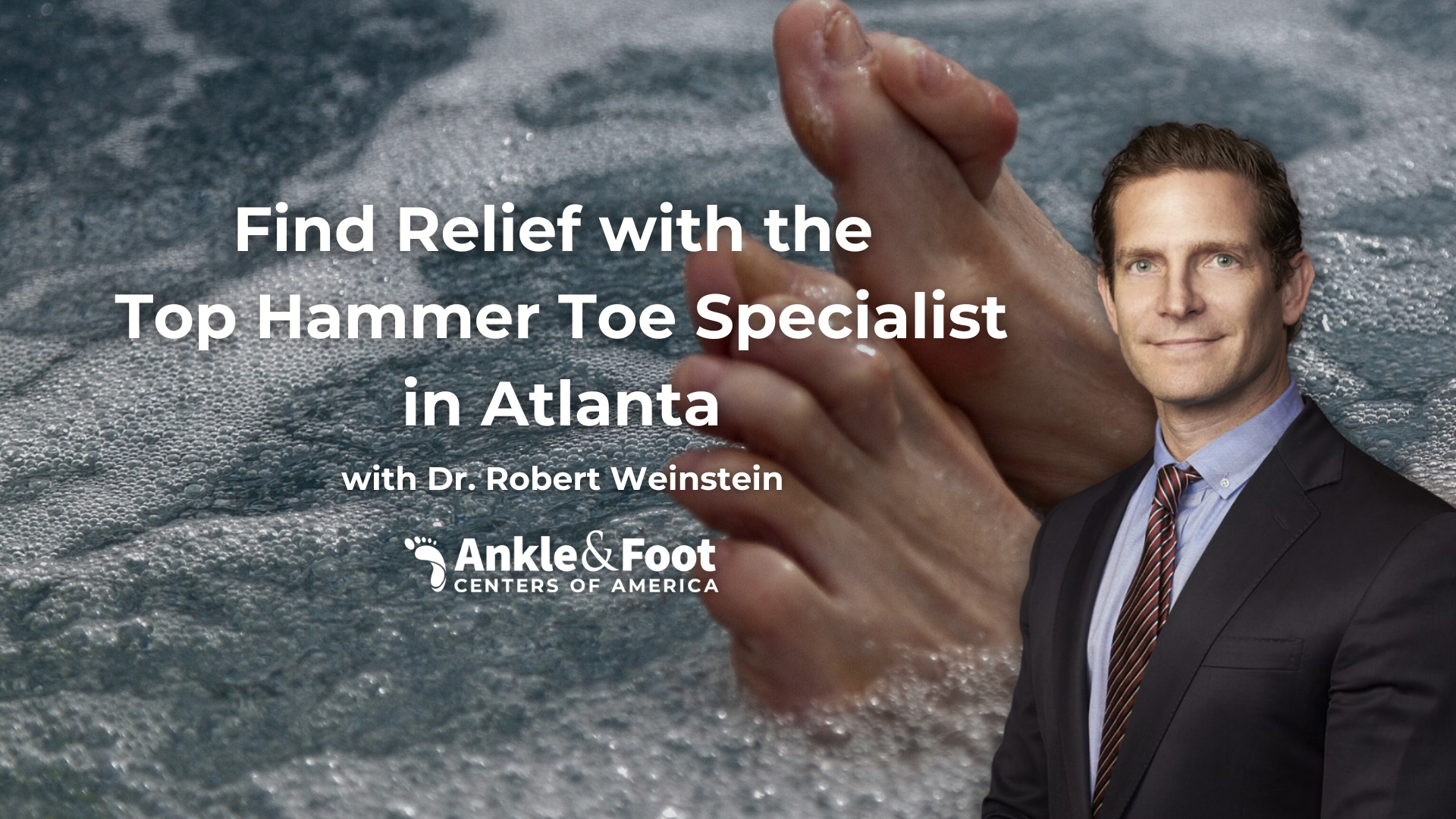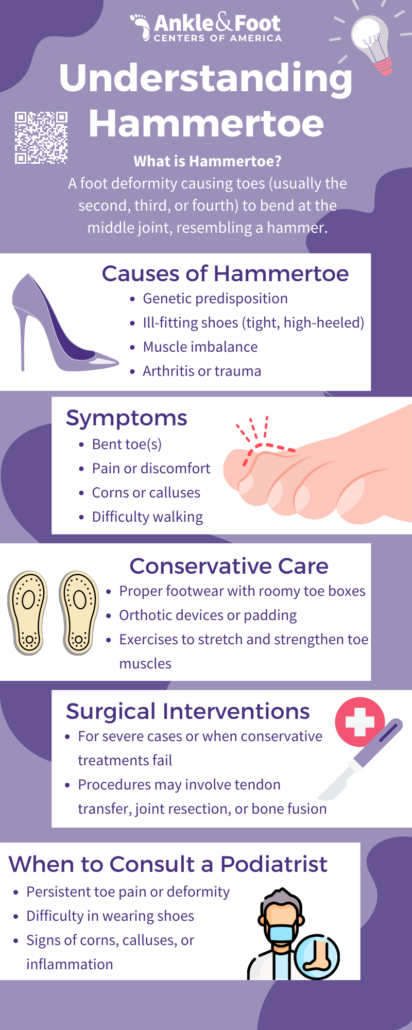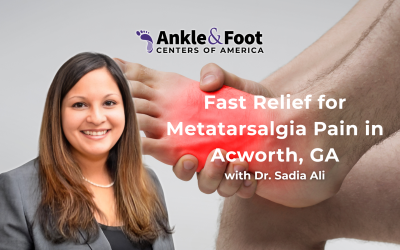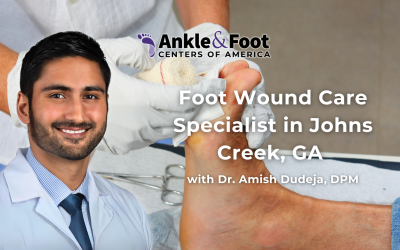Ever experienced a sharp pain in your foot when you’re walking? Or noticed an odd bend in your toes? If so, you may be dealing with a condition called hammer toe. This toe deformity can be painful and disruptive, but the good news is, it’s treatable. Let’s dive in to understand more about hammer toe, how to find the right hammer toe specialist in Atlanta, and explore both non-surgical and surgical treatment options.
Table of Contents
Key Takeaways
- Discover the top hammer toe specialist in Atlanta for high-quality care.
- Non-surgical treatments, such as orthopedic footwear and exercises, can help reduce pain.
- Take proactive steps to prevent hammertoe with appropriate footwear and foot care!
Understanding Hammer Toe: Symptoms and Causes
Suffering from a toe deformity, like hammer toe, can be both uncomfortable and painful. It is when the end of your big toe becomes curved downwards in an unnatural bent position, leading to difficulty walking as well as swelling and pain at that area. People often face this problem due to wearing shoes or footwear which are too tight around the toes. Other factors such as muscle imbalances caused by arthritis may also contribute to it.
Two types of rigid (which cannot be straightened without medical help) or flexible (manually adjustable) affect the middle joint part of the affected foot or toes respectively. Similarly, you should consult with a foot doctor if any symptoms appear so they could accurately diagnose how severe this condition might be for proper treatment plan recommendation. Although challenging living with these conditions isn’t impossible, many people have been successful in managing their issues before!
Identifying the Best Hammer Toe Specialist in Atlanta
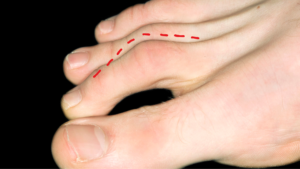 Finding the best practitioner for your hammer toe issue is essential. A top-notch professional not only gives dependable treatment options, but also educates you throughout, guaranteeing that decisions about health are based on comprehensive knowledge.
Finding the best practitioner for your hammer toe issue is essential. A top-notch professional not only gives dependable treatment options, but also educates you throughout, guaranteeing that decisions about health are based on comprehensive knowledge.
Now let’s dig deep into what characteristics a specialist in this particular field should possess and look at some of Atlanta’s finest foot facilities offering care related to issues with toes or feet including those involving hammer toes.
What to Look for in a Hammer Toe Specialist
In your quest to find the perfect hammer toe specialist, their qualifications and experience should be a main factor in evaluating them. The right one for you ought to have specialized training or expertise in podiatry or orthopedic surgery as well as an extensive knowledge of treatment options – both surgical and non-surgical ones, related to diagnosing and treating this condition. They need substantial practice with regards to performing various sorts of surgeries associated with issues concerning toes while being capable enough when it comes to managing postoperative care properly too.
Patient testimonials are very important resources that could help shed light on the amount of skill which particular physicians possess along with how successful their treatments are. Tend turn out along with each patient’s level of contentment after going through it all. These items put together can provide invaluable insights into whether they meet up expectations set forth by yourself prior to visiting them professionally speaking anyway.
Having said that, though keep at heart quite often dealing with spinal cord troubles obtaining appropriate doctor will usually dictate difference between entire recovery course take general health ends itself Such pertinent decisions simply not overlooked should try go over overall aspects consideration before concluding anything else!
Top Foot Centers and Podiatric Surgeons in Atlanta
For some of the best podiatric surgeons in Atlanta, you should consider the Ankle & Foot Centers of America. Offering convenient locations across the city, their talented podiatric surgeons like Dr. Rob Weinstein can provide effective treatments for toe deformities such as hammertoe.

Non-Surgical Hammer Toe Treatment Options
When it comes to treating hammer toe, surgery may not be necessary. As long as the condition is attended to promptly, complications such as chronic foot pain and permanent toe bending can be avoided. Footwear selection plays a huge role in managing symptoms – you should look for orthopedic shoes with good arch support or sensible footwear that provides comfort while addressing any deformity of the fourth toes involved. Other forms of assistance include corn pads which are often placed at ball-of-foot areas affected by pressure. Stretching exercises combined with regular use of toe taps also help strengthen muscles around your feet whilst reducing overall pain levels related to this particular medical issue. Lastly, special braces created specifically for correcting alignment issues among crooked fingers are an alternative treatment option when wishing to stay away from surgical procedures, they will serve both purposes of alleviating discomfort and prevent situations where impairments get worse over time because control needs maintaining!
When is Hammertoe Surgery Necessary?
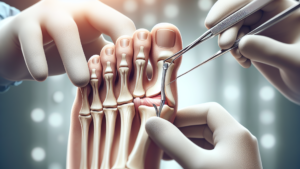 For patients with severe cases of hammertoe, sometimes the most dedicated non-surgical treatments may not be enough. Yet there is hope in undergoing a surgical procedure to address this issue – and many who have had it done can testify that such treatment has helped them greatly. Hammertoe surgery has been found quite successful for numerous people dealing with issues regarding their toe area. Thus providing some relief from pain or discomfort caused by an incorrectly aligned toe.
For patients with severe cases of hammertoe, sometimes the most dedicated non-surgical treatments may not be enough. Yet there is hope in undergoing a surgical procedure to address this issue – and many who have had it done can testify that such treatment has helped them greatly. Hammertoe surgery has been found quite successful for numerous people dealing with issues regarding their toe area. Thus providing some relief from pain or discomfort caused by an incorrectly aligned toe.
Types of Hammertoe Surgery
When it comes to hammertoe surgery, there are several options designed to meet the individual needs of each patient. These range from tendon transfer – a method which consists in redirecting a tendon located beneath the toe or pulling one close by across its top joint for better alignment – all the way up to fusion, where parts of bones constituting joints are taken away and then stabilized with pins until they fuse together into one single unit. Healing may take around four-six weeks. Although recurrence of malformation is possible if necessary precautions aren’t taken before/after procedure as well as superficial wound infection, nerve impairment or improper healing might present themselves too. Regardless, these setbacks can be confronted effectively with a proper management approach and expectations prior to starting treatment.
Recovery Period and Post-Operative Care
After undergoing hammertoe surgery, healing begins with the protection of your toe and using appropriate footwear. You can expect to be able to walk immediately after wearing a protective boot. Swelling at the surgical site may continue for some weeks afterwards. It is important that you pick out shoes which provide comfort as well as support, such as sneakers or semi-orthopedic athletic shoes—but not tight ones nor high heels! An extra layer of foot support by including shoe inserts into your outfit might also help while walking in unsuitable clothing should be avoided entirely during this period so Issues don’t develop.
The recovery timeline varies among patients, but typically involves months before any persistent symptoms are eliminated completely through therapy sessions targeting mobility increase and increased flexibility on toes. With these treatments combined with correct use of suitable footwear will facilitate an easier recuperation time from going under hammertoe surgery procedures.
Preventing Hammer Toe: Tips for Healthy Feet
When it comes to avoiding hammer toe, prevention is key. Wearing shoes with roomy toes and arch support can give your feet the protection they need from high-heeled or tight fitting footwear that causes strain on your second toe and joints which ultimately results in bent curled toes, a tell tale sign of this disorder. If calluses or corns are present, pumice stones should be used as treatment method before considering surgery for more serious cases, according to podiatry experts advice. To ensure overall foot health, think ahead by investing in quality shoes and sensible exercises so that you do not experience any problems related to Hammertoe in the future.
Summary
Undertaking the journey of managing hammer toe can be done with proper knowledge, medical support and determination. Knowing about this condition is essential to preventing it as well as exploring available treatment options – both surgical and non-surgical ones, for relieving any pain in your toes or feet. All these steps taken together will ensure a comfortable life without experiencing discomfort due to hammer toe again.
Frequently Asked Questions
What is the best doctor to treat hammer toe?
I was happy to be seen by the specialist who specializes in foot and ankle issues. A Podiatric Surgeon. Before arriving, I had written down my concerns about hammer toe so that when we met he could address them quickly and thoroughly. He showed such hospitality while listening intently to what I had to say regarding this situation with my toe.
Who should I see for hammer toes?
If you’re having difficulty walking or your joint is stiff and causing pain, then it’s time to make an appointment with either a doctor or podiatrist regarding potential hammer toes. Don’t delay, take action today! Signs of this condition can be swelling in the toe area so don’t ignore any warning signs as they may lead to complications down the line if not treated properly.
What is the new procedure for hammer toes?
Your feet can feel like new again with the TenoTac® System! This treatment works to rebalance the tendons on your toe and help restore it back into its natural shape. It’s a simple solution for those suffering from hammer toes.
Take advantage of this effective procedure now and get ready to show off healthy, happy feet once again!
Does insurance pay for hammer toe surgery?
Hammer toe surgery, when it is determined to be medically necessary, will likely be covered by insurance. If the goal of treatment is merely for aesthetic purposes, then it may not have coverage.
What is hammer toe and what are its symptoms?
The toe can suffer a painful deformation, called hammer toe, which makes it bend downward. This unfortunate condition may be hard to deal with as it triggers difficulty walking and causes swellings that often develop into corns or calluses too.

